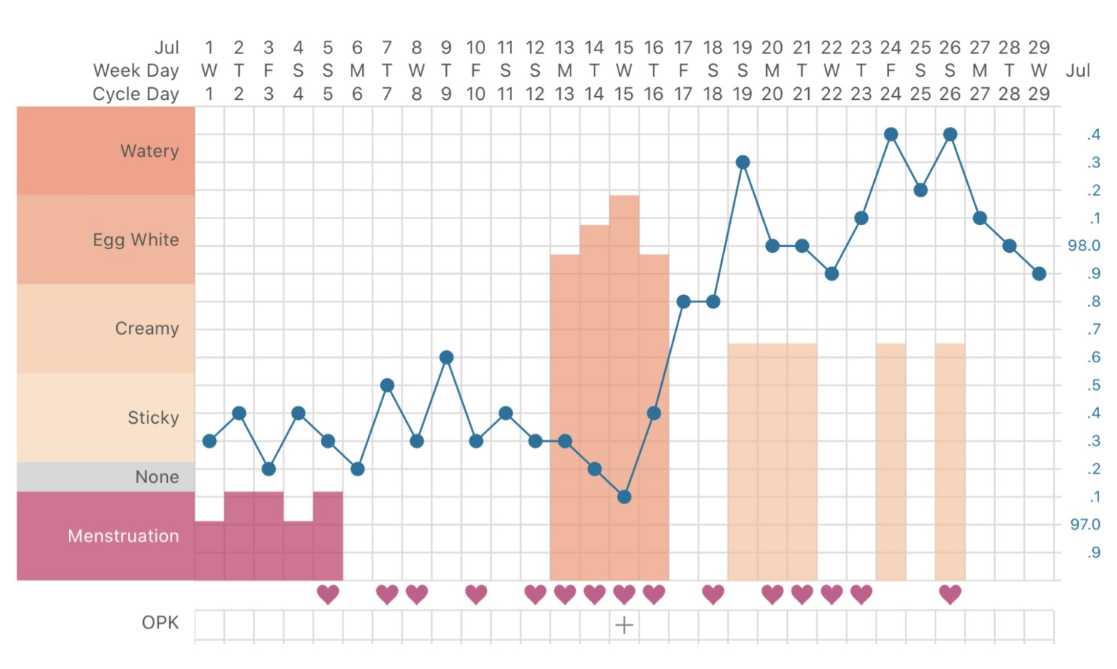<< Back to Patient’s Resources page
Kindara / Paper Basal Body Temperature (BBT) Chart Instructions
What is Basal Body Temperature?
Basal body temperature is your resting (waking) body temperature. Before ovulation, waking temperatures tend to be in the mid 97 range. Temperatures typically rise to the mid 98 range a day or so after ovulation. This is because after ovulation the body begins to produce a heat-inducing hormone called progesterone which slightly elevates body temperature. Therefore, BBT charting is NOT a tool for predicting ovulation, (an ovulation predictor kit does that job). The BBT chart is a tool that gives a time-lapse picture of hormonal changes that is very useful clinically to determine the best possible treatment for you.
Downloading the Kindara app:
The BBT charting app we prefer our patients to use is Kindara. We have found this to be the most accurate and easiest to use. You can download the Kindara app here. Once you have created a login and account, you can share your chart with us. Click the lower right “more” tab, then click on “share Kindara” and then “share with practitioner” and then enter the email address: info@lararosenthal.com. This gives us access to your chart which makes it easier to answer questions between sessions should they come up.
Using Paper BBT Charts:
If you prefer to use a paper BBT Chart (linked here), please make sure to bring your completed chart to each visit.
How to use a BBT chart:
Pick a time when you will take your temperature – i.e. 7am – and try to take it at roughly the same time every day (within a half hour), first thing upon waking, and before any other activity such as using the bathroom, brushing your teeth, or talking on the phone… Definitely before taking a shower or walking the dog because this will get your blood flowing and raise your body temperature. If you forget and take a shower or brush your teeth just skip that day since it no longer represents resting body temperature. Please DO NOT set an alarm in order to take your temperature. In order of priorities, sleep trumps taking your BBT so get your sleep and convert the temperature (see below). Please use an oral thermometer that takes at least 30 seconds to register.
How to convert BBT temperatures if you wake up early or late:
Body temperature rises the later you sleep. The conversion is one tenth of a degree per half hour of additional sleep time. For example: if your usual time for taking your temperature is 7am and one day you sleep til 9am and your temp at 9am is 97.5, you have slept 2 hours (4x30min) longer so you can subtract 0.4 degrees (4x 0.1 degrees) and the temperature you will enter into your BBT chart is 97.1 degrees. Alternatively, if you prefer to use a converter to calculate your adjusted BBT temp here is a link.
Please also mark these items:
Day 1 of your menses and blood flow. The first day of true blood flow is considered Day 1. This is when you would notice blood in the toilet after urinating. If you are spotting, please note it as spotting but it’s not considered Day 1 as spotting can happen at many different points in the cycle.
If you are trying to get pregnant, please mark the days that you have intercourse.
In the “cervical fluid” row please mark the quality of the cervical fluid on the days you observe it. (eggwhite, rubber cement, lotiony, etc). When you get close to ovulation, your body will begin to develop a wet quality cervical fluid. This cervical fluid varies in consistency but the MOST fertile fluid looks and feels like raw eggwhite – it is stretchy and wet. This is your body’s signal of peak fertility.
If you are using an ovulation predictor kit, please mark the days it shows positive.
Many other factors can affect temperature. Travel (especially across time zones), illness, restless sleep, alcohol, spicy food, an unusually hot sleeping environment or with heating pads can also cause temperatures to rise. Please note any of these factors in the rows at the bottom with space for notes.
For more in-depth reading, please see Taking Charge of Your Fertility by Toni Weschler.

